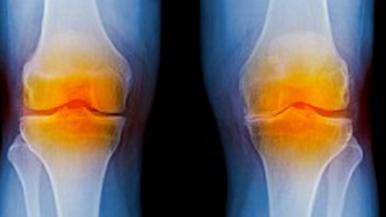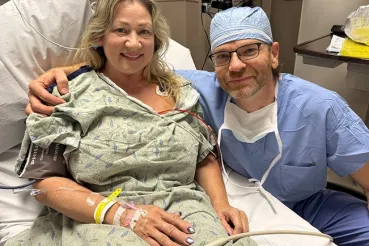Wear and tear on joints are a natural part of aging — so, too, are the inevitable aches and pains that come with it. Knee pain, in particular, is one of the most common joint problems.
While past generations often put off seeing a doctor for knee pain, today's active adults are finding relief with total knee replacement surgery. People who cannot function day-to-day because of knee pain or those unable to walk independently are often good candidates for this surgery.
"If you experience so much pain that you cannot sleep at night, something needs to be done," says Aaron Rosenberg, MD, a joint replacement surgeon at Rush.
During a total knee replacement, an orthopedic surgeon removes deteriorating joint surfaces and a bit of bone in the knee and replaces them with metal and plastic implants that should last about 20 years.
What do you need to know about knee pain and knee replacement? Rosenberg shares some tips here.
1. Trauma to the knee may lead to joint deterioration.
The most common reason for knee replacement is knee pain from osteoarthritis, rather than a specific trauma to the knee.
A blow to the knee that damages knee ligaments does not typically cause problems with the joint surface. Orthopedic surgeons usually treat these injuries (commonly known as a blown-out knee) with ligament reconstruction, immobilization and/or rehabilitation.
However, about 5 to 10 percent of patients who need knee joint replacement have a history of blowing out their knees.
"Sometimes the trauma when you blow out your knee causes problems after a period of time — whether it is one year or 20 years later," says Rosenberg. "The joint surface deteriorates because the ligaments are no longer holding the knee together as appropriately as they should be and you get gradual deterioration of the joint surfaces."
To avoid ligament damage to your knee, Rosenberg recommends limiting high-impact activities such as competitive one-on-one basketball games that have a lot of twisting, turning, stopping and starting.
2. Knee replacement surgery has improved over the years.
In the late 1970s and early 1980s, people often heard about knee replacement surgeries gone wrong. Those suffering with knee pain regularly waited until they were wheelchair bound before seeking treatment; knee replacement was the last resort.
But times have changed. "We used to see people in the much later stages of the arthritic process, but we rarely see people like that nowadays," says Rosenberg.
Knee replacement surgeries are more consistent now thanks to new techniques, technologies and materials. For instance, there are now up to 200 implant size variations, compared to just three or four sizes 30 years ago.
"Using the proper implant size leads to even better range of motion and less pain," says Rosenberg.
And today's joint replacement surgical systems are designed to help orthopedic surgeons make more precise cuts, place implants more precisely and minimize soft tissue damage for optimal results.
The latest innovation is robotic-assisted knee replacement (e.g., Mako), which offers a truly personalized approach.
With this procedure, the surgeon creates a 3D virtual model of the joint and uses that model to determine the optimal size, placement and alignment of the implant. The surgery itself is guided by real-time data, so the surgeon can make necessary adjustments throughout the surgery.
Several joint replacement surgeons at Rush are now performing robotic-assisted partial and total knee replacement.
Exercise and weight loss can help reduce symptoms of osteoarthritis in the knee, improve knee function and possibly reduce disease progression.
3. Surgery is not the only option.
There are plenty of noninvasive treatments to try before surgery. Some of these treatments include physical therapy; medications to reduce pain and inflammation; and using an assistive device like a cane.
Another option is partial knee replacement, which is designed for people whose osteoarthritis is limited to just one part of the knee. For a partial knee replacement, orthopedic surgeons replace only the damaged part of the knee, while the healthy cartilage and bone in the knee remain in place.
Patients typically recover more quickly and have less pain than with total knee replacement. However, there is the potential that patients will need additional procedures in the future if arthritis develops in parts of the knee that have not been replaced.
4. Weight loss and exercise can help reduce knee pain.
Obesity increases the risk of osteoarthritis in the knee because it increases pressure on the knee joint. Further, obese people tend to do less physical activity, which creates a loss of muscle that surrounds and protects the knee joint.
Exercise and weight loss can also help reduce symptoms of osteoarthritis in the knee, improve knee function and possibly reduce disease progression.
While knee pain may make it difficult to exercise, certain physical therapy exercises can help strengthen muscles in ways that can minimize the amount of discomfort in the knee.
"Building up the muscles around the knee joint takes some of the stress off the joint itself," says Rosenberg.
5. The jury is still out on minimally invasive knee replacement.
More research is needed on the long-term function and durability of minimally invasive total knee replacement, according to the American Academy of Orthopaedic Surgeons. Minimally invasive knee replacement uses a smaller incision and attempts to minimize damage to the soft tissues around the knee.
While some studies have shown that minimally invasive knee replacement may result in less blood loss, shorter hospital stays and better motion than traditional surgery, other studies have found a higher rate of complications with minimally invasive knee surgery, including poorer position of the knee implants.
"Orthopedic surgeons have discovered that sometimes you need a larger incision in order to minimize the soft tissue damage and make sure the implant parts go in correctly," says Rosenberg.
"Perhaps more important, we have gotten much better at reducing the amount of postoperative discomfort and pain experienced in traditional knee replacement, which also allows for a much more rapid recovery."
Talk to your doctor to learn whether minimally invasive knee replacement is a good option for you.




